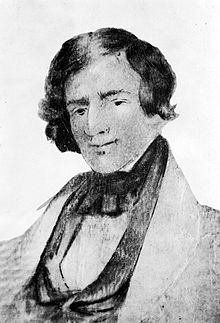
Back جيديدايا سميث Arabic چيديدياه سميث ARZ Джедидая Смит Bulgarian Jedediah Smith Catalan Jedediah Smith Danish Jedediah Smith German Jedediah Smith Spanish Jedediah Smith Finnish Jedediah Smith French ג'דדיה סמית HE
Jedediah Smith | |
|---|---|
 Life portrait, said to have been drawn by a friend, from memory, after Smith's death[1] | |
| Born | Jedediah Strong Smith January 6, 1799[2] |
| Died | May 27, 1831 (aged 32) near Lower Spring, Territory of Santa Fe de Nuevo México, Mexico (south of present-day Ulysses, Grant County) |
| Cause of death | Attacked by Native Americans |
| Nationality | American |
| Other names |
|
| Occupations |
|
| Employer(s) | Ashley-Henry Fur Company, partner in the Ashley Smith Fur Company and Smith, Jackson and Sublette |
| Known for |
|
Jedediah Strong Smith (January 6, 1799 – May 27, 1831) was an American clerk, transcontinental pioneer, frontiersman, hunter, trapper, author, cartographer, mountain man and explorer of the Rocky Mountains, the Western United States, and the Southwest during the early 19th century. After 75 years of obscurity following his death, Smith was rediscovered as the American whose explorations led to the use of the 20-mile (32 km)-wide South Pass as the dominant route across the Continental Divide for pioneers on the Oregon Trail.
Coming from modest family background, Smith traveled to St. Louis and joined William H. Ashley and Andrew Henry's fur trading company in 1822. Smith led the first documented exploration from the Salt Lake frontier to the Colorado River. From there, Smith's party became the first United States citizens to cross the Mojave Desert into what is now the state of California but which at that time was part of Mexico. On the return journey, Smith and his companions were likewise the first U.S. citizens to explore and cross the Sierra Nevada and the treacherous Great Basin Desert. The following year, Smith and companions were the first U.S. explorers to travel north from California overland to the Oregon Country. Surviving three Native American massacres and one bear mauling, Smith's explorations and documented travels were important resources to later American westward expansion.
In March 1831, while in St. Louis, Smith requested of Secretary of War John H. Eaton a federally-funded exploration of the West, but to no avail. Smith informed Eaton that he was completing a map of the West derived from his own journeys. In May, Smith and his partners launched a planned paramilitary trading party to Santa Fe. On May 27, while searching for water in present-day southwest Kansas, Smith disappeared. It was learned weeks later that he had been killed during an encounter with the Comanche – his body was never recovered.
After his death, Smith and his accomplishments were mostly forgotten by Americans. At the beginning of the 20th century, scholars and historians made efforts to recognize and study his achievements. In 1918, a book by Harrison Clifford Dale was published covering Ashley-Smith's western explorations. In 1935, Smith's summary autobiography was finally listed in a biographical dictionary. Smith's first comprehensive biography by Maurice S. Sullivan was published in 1936. A popular Smith biography by Dale Morgan, published in 1953, established Smith as an authentic national hero. Smith's map of the West in 1831 was used by the U.S. Army, including western explorer John C. Frémont, during the early 1840s.
- ^ Smith et al.
- ^ Barbour 2011, p. 15.
© MMXXIII Rich X Search. We shall prevail. All rights reserved. Rich X Search